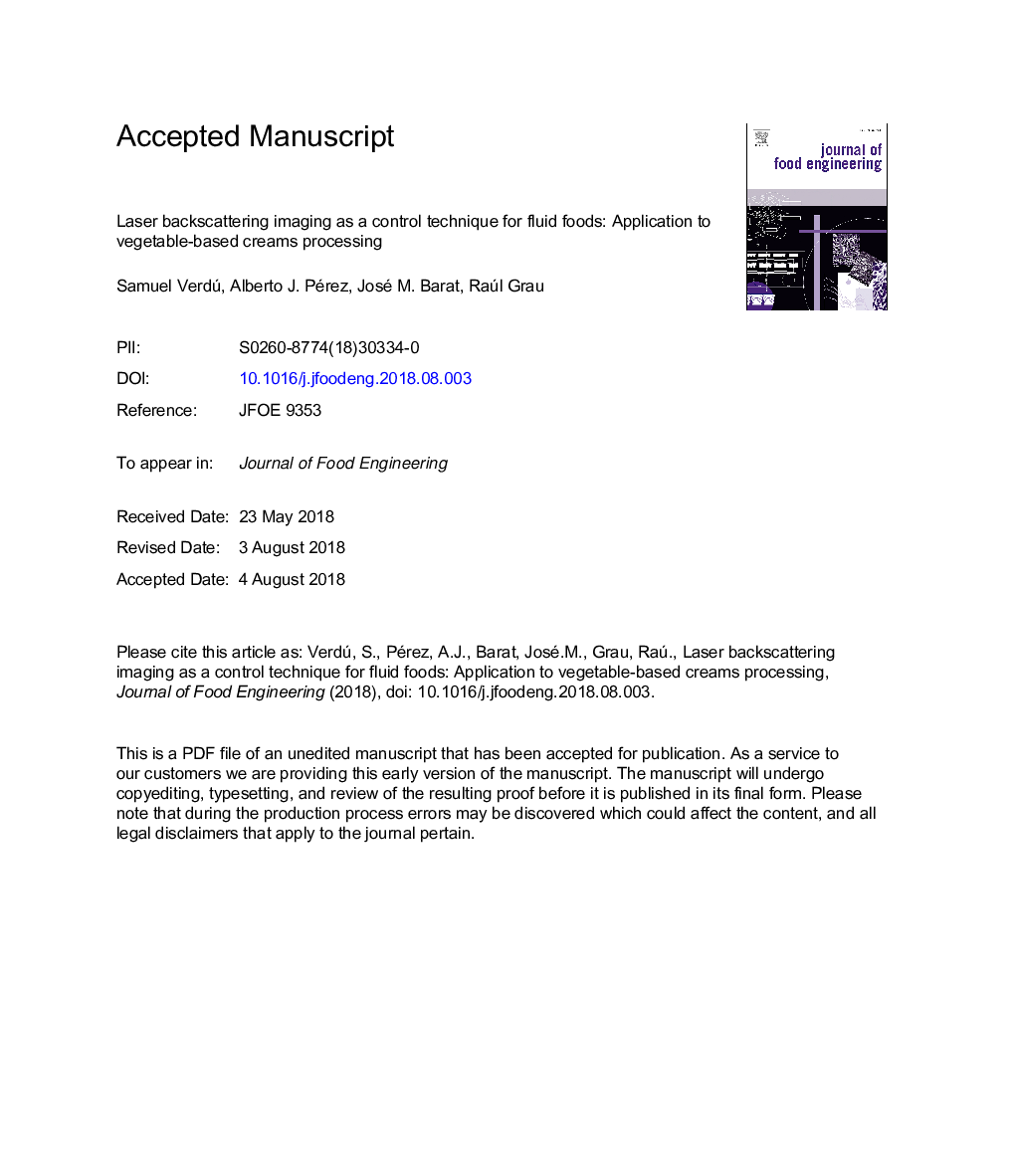| کد مقاله | کد نشریه | سال انتشار | مقاله انگلیسی | نسخه تمام متن |
|---|---|---|---|---|
| 6664347 | 1427060 | 2019 | 37 صفحه PDF | دانلود رایگان |
عنوان انگلیسی مقاله ISI
Laser backscattering imaging as a control technique for fluid foods: Application to vegetable-based creams processing
ترجمه فارسی عنوان
تصویربرداری بکار رفته در لیزر به عنوان یک تکنیک کنترل برای غذاهای مایع: کاربرد در پردازش کرمهای گیاهی
دانلود مقاله + سفارش ترجمه
دانلود مقاله ISI انگلیسی
رایگان برای ایرانیان
کلمات کلیدی
کرم سبزیجات، تجزیه و تحلیل تصویربرداری، برگشت لیزر، رئوئولوژی، کنترل کیفیت،
ترجمه چکیده
در این کار، استفاده از یک تکنیک تصویر بردار لیزری به عنوان یک روش کنترل کیفیت غیر مخرب برای ماتریس مواد مایع مورد مطالعه قرار گرفت. ماتریس مواد غذایی مورد استفاده بر اساس کرم های گیاهی بود که با توجه به ترکیب چهار عامل تولید (مواد خام، نوع بیوپلیمر، غلظت بیوپلیمر و سیستم همگن شدن) اصلاح شد تا فضای گسترده واریانس را از لحاظ خواص فیزیکی و شیمیایی بدست آورد (52 کرم مختلف). تمام کرمها براساس تکنیک تصویربرداری با استفاده از توصیفگرهای پیش طراحی شده استخراج شده از قطعه الگوهای لیزر تولید شده مشخص شد. ظرفیت ارزیابی کرم ها از طریق داده های تصویربرداری و فیزیکی و شیمیایی (رئولیسم و سینرزس) مقایسه شد و اثر هر عامل تولید بر روی واریانس اسکن شده آنها مورد ارزیابی قرار گرفت. هر دو مشخصه مشابه بودند. این همبستگی با مدل سازی رابطه بین آنها با انجام مطالعات رگرسیون ثابت شده است. ضرایب رگرسیون برای اکثر متغیرهای فیزیکی و شیمیایی موفق بوده اند. با این حال، پیش بینی خواص کرم ها هنگامی که با ترکیب خطی همه آنها انجام می شود، حداکثر می شود. به این ترتیب، توصیفگرهای تصویربرداری واریانس کافی را از دسته کرم جمع آوری کردند تا آنها را با توجه به خواص فیزیکی و شیمیایی آنها در فضای تولید واریانس فیزیکی و شیمیایی قرار دهند. نتایج به ما این امکان را داد تا نتیجه گیری کنیم که این روش می تواند برای کنترل کیفیت غیر مخرب ماتریس مایع مواد غذایی برای فرایندهای تولید با طیف گسترده ای از دسته های محصول مورد استفاده قرار گیرد.
موضوعات مرتبط
مهندسی و علوم پایه
مهندسی شیمی
مهندسی شیمی (عمومی)
چکیده انگلیسی
In this work, the application of a laser backscattering image technique as a non-destructive quality control technique for fluid food matrices was studied. The used food matrices were vegetable-based creams, which were modified according to the combination of four production factors (raw material, biopolymer type, biopolymer concentration and homogenisation system) in order to obtain a wide space of variance in terms of physico-chemical properties (52 different creams). All the creams were characterised based on that imaging technique using pre-designed descriptors extracted from the captures of the generated laser patterns. The capacity to characterise creams presented by the imaging and physico-chemical data (rheology and syneresis) was compared, and the effect of each production factor on their captured variance was evaluated. Both characterisations were similar. This parallelism was proved by modelling the relationship between them by carrying out regression studies. The regression coefficients were successful for most physico-chemical variables. However, the prediction of creams' properties was maximised when done over the linear combination of them all. Thus the imaging descriptors collected enough variance from the cream categories to place them according to their physico-chemical properties into the generated space of physico-chemical variance. The results allowed us to conclude that this technique can be applied for the non-destructive quality control of fluid-food matrices for production processes with a wide spectrum of product categories.
ناشر
Database: Elsevier - ScienceDirect (ساینس دایرکت)
Journal: Journal of Food Engineering - Volume 241, January 2019, Pages 58-66
Journal: Journal of Food Engineering - Volume 241, January 2019, Pages 58-66
نویسندگان
Samuel Verdú, Alberto J. Pérez, José M. Barat, Raúl Grau,
